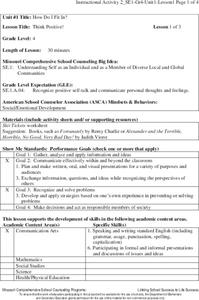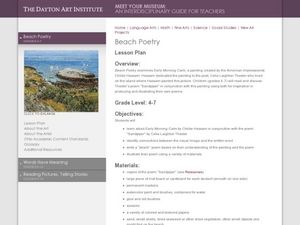Curated OER
Lesson: Tomma Abts: Abstract Painting
One must first learn how to analyze art before they can properly respond to it. Here, young analysts examine six abstract pieces in a systematic and formal way. They then respond to one of the pieces in either a poem or an essay. An...
Curated OER
Lesson Plan: Finding Treasures Within
Sherlock Holmes had fantastic skills of observation. Your super sleuths will examine the pattern, rhythm, texture, and color of a painting to uncover the symbolism beneath. A great lesson, that incorporates observation, art analysis,...
Curated OER
Seeing the Image in Imagery: A Lesson Plan Using Film
In our increasingly visual society, it is often difficult for some readers to create a mental picture of a picture created only with words. An image-rich text like F. Scott Fitzgerald's The Great Gatsby can therefore, present a real...
Curated OER
Lesson: Younger Than Jesus: Is a Young Generation's Multimedia Work Art?
How has art changed? Are young people artists? What is art? These questions are up for discussion as critical thinkers examine several works of art expressed through multimedia. There are five different sessions outlined, complete with...
Curated OER
Bridge to Terabithia: Visualizing to Optimize Comprehension
Good readers visualize. And in our image-rich culture it is imperative that children are provided with opportunities to practice this important skill. A selection from Shel Silverstein’s Where the Sidewalk Ends and Bridge to Terabithia,...
Haut Gap Middle School
Root Words
Scholars demonstrate their knowledge of root words aqua and aud, and develop vocabulary skills by completing of a chart, handout, and worksheet using creative thinking skills, a dictionary, and a thesaurus.
Curated OER
Maus: Making a Visual Representation
How do you represent a tragic event? Are stories of tragic events better left untold? After reading chapter two of Maus and studying other representations of the Holocaust (suggestions are included), class members create a representation...
Novelinks
Zach’s Lie: Guided Imagery
Close your eyes and picture a time where you decided to tell the truth to someone. What were you wearing? How did you feel? Such prompts begin a guided imagery activity for Zach's Lie. Directions for creating an environment conducive to...
Missouri Department of Elementary
Think Positive!
Following an attention-grabbing read-aloud, scholars brainstorm ways they can change negative thoughts into positive thoughts. Small groups plan and perform a skit that showcases one of the new ideas to uplift one's feelings....
Creative Visions Foundation
Creating Your Own Original Interpretation of the UDHR
How can visual aids enhance understanding of a complex topic? With the third of four lessons from the Introduction to the Declaration of Human Rights (UDHR) set, scholars view illustrations online from the book We Are All Born Free and...
Curated OER
Positive/Negative Bugs
Bugs can be creepy - and fun! Kids create a positive and negative design by repeatedly drawing a simple insect overlaid with a geometric shape. The outcome is really neat and will help build spacial reasoning, visual acuteness, and...
Denver Art Museum
Lesson: That's Not Natural
Any time kids engage in a design project, they are building problem-solving skills, collaborative learning skills, and creative thinking skills. Upper graders take a nature walk to observe and sketch organic shapes and lines that they...
Math Stars
Math Stars: A Problem-Solving Newsletter Grade 6
Think, question, brainstorm, and make your way through a newsletter full of puzzles and word problems. The resource includes 10 different newsletters, all with interesting problems, to give class members an out-of-the box math experience.
Perkins School for the Blind
Silly or Sensible?
Is it silly or sensible? That's a great question, and it's the question that will drive this entire lesson. Learners with special needs and visual impairments work together to analyze verbal information. The instructor makes a statement,...
Curated OER
Lesson: Mary Heilmann: To Be Someone
Kids consider the pure abstraction and minimalism found in Mary Heilmann's work. They analyze several of her pieces through critical discussion and then think about her use of a song title as the title of her exhibit. Learners then use a...
Curated OER
Lesson: Urs Fischer: Your Choice: Reality or Illusion?
Young analysts write a comparative essay, but about what? They compose a paper based on several critical discussion about reality and illusion, and how both are blurred in art. They analyze several theatre pieces that exemplify Brechtian...
Curated OER
Lesson: Paul Chan: "Score for the 7th Light"
Music, art, and poetry coalesce in a single exhibition, and in a single lesson. Critical thinkers analyze the Fluxus art movement as it's seen in the work of Paul Chan's 7 Lights. They consider the use of poetry and music in his work,...
CTC Publishing
Interrupting
Everybody loves to contribute to the conversation, but it needs to be done politely so as not to interrupt. Help your little ones learn how to add to a conversation appropriately with a few activities that complement the book, My Mouth...
Curated OER
I Have A Dream - Pastel Drawings
Discuss the meaning of Martin Luther King Jr.'s "I Have A Dream" speech, explore figurative language, and read about Harriet Tubman and her courage. After the discussion, learners analyze painter/author Jacob Lawrence's use of...
Curated OER
Beach Poetry
Familiarize young analysts with the relationship between words, meaning, and visual images. They consider the relationship between the painting Beach Poetry and the poem Sandpaper. They compose and illustrate an original a beach poem...
Macmillan Education
Organising Your Studies
What's the best way to study? Well, it depends. . . Session two of a 23-lesson life skills series focuses on a variety of study skills strategies and suggests when/why to choose one over another.
Curated OER
Lesson: After Nature: Visions and Visionaries
Build visual literacy, discussion, and critical thinking skills with an innovative art lesson. Young analysts discuss the use of decalcomania, surrealism, and automatism in various contemporary pieces, discuss constructed truth, and...
Concordia University Chicago
The Pietá by Michelangelo Buonarroti
Why is arts education so important? It builds critical thinking, analysis and creative problem-solving skills. Learners review the life of Michelangelo Buonarroti, and then analyze his piece, The Pieta. After that, they'll sculpt a human...
Curated OER
Introduce a Weather Unit
Engage your learners by playing Water Music Suite by Handel. Different types of weather sounds play on the recording, and it's an easy lead into talking about the weather! What is weather? What kinds of weather exist? What is it called...

























